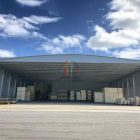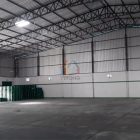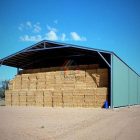How to design the large metal shed?
The design of large metal shed is a complex and important process that requires consideration of several factors including structural strength, functional requirements, sustainability and aesthetics. This article will describe some key design considerations and provide a step-by-step guide to designing a large metal shed.
First, structural strength is one of the most important considerations when designing a large metal shed. Metal sheds need to be able to withstand wind and snow loads in all weather conditions and maintain structural stability. Therefore, during the design process, detailed structural calculations and simulation analyzes are required to ensure the use of sufficient materials and proper structural design to ensure the structural strength of the metal shed.
Second, functional requirements are another important factor to consider when designing a large metal shed. According to the purpose of the metal shed, the designer needs to determine the size, height and layout of the metal shed. For example, if the metal shed will be used to store and protect large machinery and equipment, the designer needs to ensure that the metal shed is spacious enough to accommodate the size and quantity of the equipment. Additionally, metal sheds may require equipment ventilation and lighting systems to meet specific functional needs.
Sustainability is also an important consideration in modern building design. When designing large metal sheds, renewable materials such as recycled metal can be used to reduce resource consumption and environmental impact. In addition, designers can consider using solar panels to provide energy for metal sheds, reducing dependence on traditional energy sources. With these sustainability measures, designers can make large metal sheds more environmentally friendly and contribute to a sustainable future.
Finally, aesthetics are also an important factor to consider when designing a large metal shed. Although metal sheds are commonly used for industrial and commercial purposes, their appearance should also be considered an important design element. Designers can enhance the overall aesthetics of a metal shed by choosing appropriate exterior materials and colors, as well as by considering the proportions and shape of the metal shed. In addition, designers can also use greenery and landscaping to blend in with the surrounding environment and make the metal shed more attractive.

When designing a large metal shed, here are some step-by-step guides that can help designers through the design process:
1. Determine the purpose and functional requirements of the metal shed. This includes determining the size, height and layout of the metal sheds, as well as any special functional needs.
2. Carry out structural calculation and simulation analysis to determine the structural strength of the metal sheds. This can be done by using professional structural design software.
3. Select appropriate materials and building systems to meet the structural and functional needs of the metal shed. This can include selecting appropriate metallic and exterior materials, as well as identifying appropriate building systems such as ventilation and lighting systems.
4. Consider sustainability measures such as the use of renewable materials and solar panels. This can be achieved by working with a professional team to jointly develop a sustainability strategy.
5. Design the exterior of the metal sheds, including selecting appropriate colors, exterior materials, and landscaping. This can be achieved by working with landscape architects and architects.
In conclusion, designing the large metal shed is a complex and important process that takes into account multiple factors such as structural strength, functional requirements, sustainability and aesthetics. By following the step-by-step guide above, and working with a professional team, a designer can successfully design a large metal shed that is functional, sustainable, and aesthetically pleasing.












